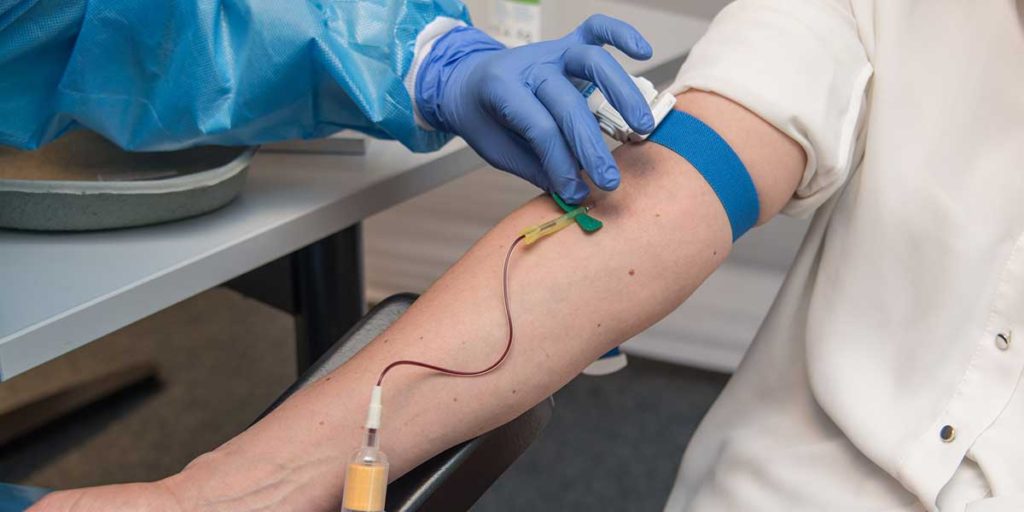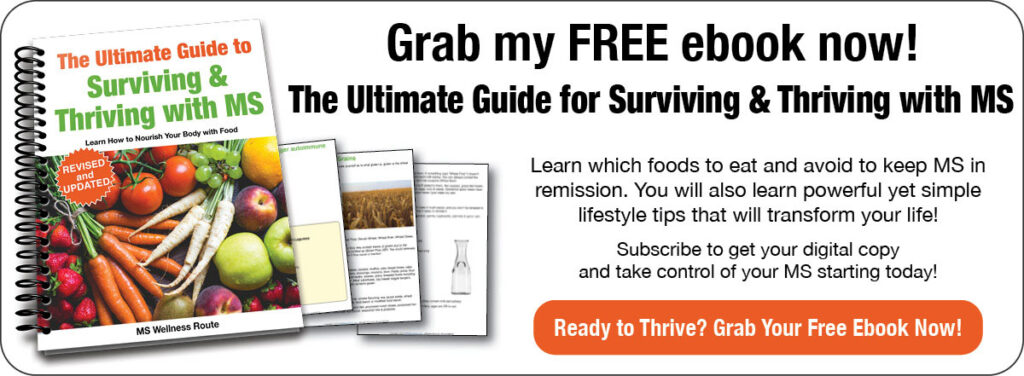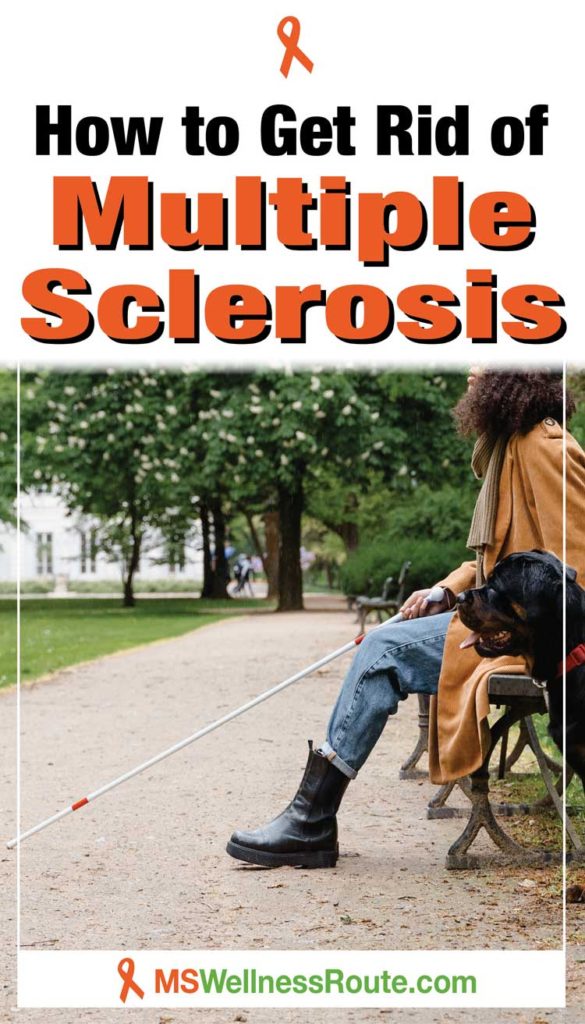Last Updated on November 18, 2023 by Cathy

Multiple sclerosis (MS) is a chronic inflammatory disease of the central nervous system. It attacks the nerve fibers and myelin sheath which protects the nerves. Nearly one million people in the U.S. and more than 2.3 million people worldwide have MS.
Unfortunately, you can’t get rid of MS. Once diagnosed with MS, you will always have MS. There are pharmaceutical drugs you can take but they don’t cure or get rid of MS. Plus, they come with nasty side effects.
If the drugs work, they only slow the disease progression down. They don’t repair the damage caused to myelin (the protective covering around nerves). Drugs don’t treat the root cause of MS.
“Conventional therapies for MS are based on the use of anti-inflammatory and immunomodulatory drugs, but these treatments are not able to stop the destruction of nerve tissue.” – PubMed (U.S. medical database)
Yes, you can’t get rid of MS but you can learn to manage it and put it into remission by lowering inflammation. MS is a chronic inflammatory disease of the central nervous system. In other words, long-term inflammation causes MS.
Inflammation is part of your body’s defense system. It sends warning signals which help your body heal. Chronic inflammation is when your body sends warning signals when there is no danger.
In MS, chronic inflammation attacks the brain, central nervous system, and optic nerve. Left untreated it can lead to severe nerve damage. Symptoms range from numbness, tingling, and weakness to severe symptoms such as paralysis.
With MS you never know when it is going to strike. The longer you have had MS the more damage can happen. That is why it is important to do something now before MS has a chance to further ravage your body.
Wouldn’t it be nice to get MS into remission and be rid of all your symptoms?
Environmental Factors

The cause of MS is due to genetic predisposition and environmental factors. Over time, these factors trigger many events in the immune system leading to MS.
You can’t change your genes but you can change your gene expression by living a healthy lifestyle. Plus, genetics only plays a small role.
Researchers discovered this when they studied identical twins. When one twin has MS the odds that the other twin will develop MS is only a 30% chance. This means there’s a 70% chance the other twin won’t have MS.
This led researchers to believe environmental factors were the contributing factor. It is a person’s habits and exposures that determine whether they develop MS or not.
This is good news. – Why?
Because YOU can control your environment and your behavior.
For more information about genetics and MS read DNA Test for Multiple Sclerosis
Poor Lifestyle Choices
Since genetics plays a small role, the primary cause of MS is due to poor lifestyle choices. Diet plays a huge role, what you eat can either raise inflammation or lower it.
Do you eat processed or sugary foods? Do you at fast-food restaurants often? Eating these unhealthy foods increases inflammation in your body. It also causes weight gain, increased blood sugar, and diseases.
Common chronic inflammatory diseases include:
- Alzheimer’s disease
- Asthma
- Autoimmune diseases such as MS
- Cancer
- Cardiovascular disease
- COPD (chronic obstructive lung disease)
- Depression and anxiety
- Inflammatory bowel disease (Crohn’s disease or ulcerative colitis)
- Osteoporosis or osteopenia
- Stroke
- Type 2 diabetes (type 1 diabetes is an autoimmune disease)
Tests for Inflammation

Having MS you can assume you have a high level of inflammation. There are signs of inflammation you can watch for such as:
- Body pain
- Chronic fatigue and insomnia
- Constipation or diarrhea
- Heartburn and acid reflux
- Mood disorders, anxiety, and depression
- Skin issues such as acne or rashes
- Weight loss or weight gain
It is a good idea to get tested. This will give you a starting point so you can track your progress. A simple blood test can detect markers of inflammation in your body.
The tests can’t tell you where the inflammation is coming from, only how much inflammation you have. Conventional doctors have a scale they follow. But, for people with an autoimmune disease, like MS, the numbers need to be more strict.
For example, conventional doctors consider 30 ng/mL vitamin D levels to be normal. For people with MS it needs to be higher, at least 60 ng/mL. Which is twice the number of the conventional reference range.
To learn more about getting the proper level of vitamin D read Multiple Sclerosis And Vitamin D
To get tested talk to your doctor or use an online lab. Online labs are easy to use and can be less expensive than visiting your doctor. You just order it online then visit a local lab to draw the blood. You will receive an email when your results are available to view.
Tests you should consider getting include:
- CRP (C-reactive protein) – a protein made by the liver. For an optimal CRP level, aim for 1 mg or lower.
- Homocysteine – a type of amino acid, it is a building block for your body to make proteins. It is also a good indicator that you have a B12 vitamin deficiency. For an optimal homocysteine level, aim for 6-9 umol/L.
Eat an Anti-inflammatory Diet

What you do and what you eat will determine your level of inflammation. If you don’t make changes to your lifestyle your body will continue to get worse. The first step is to start eating an anti-inflammatory diet. This is not a temporary diet, this is a lifestyle change for the better.
As you adapt to an anti-inflammatory diet you may notice changes such as:
- Better sleep
- Clearer skin
- Fewer flares or less intense flares
- Healthy weight
- Improved bowel movements
- Less pain
- More energy
- Reduced anxiety and depression
Anti-inflammatory foods include a well-balanced diet of colorful fruits and vegetables. Along with herbs, healthy fats, nuts, seeds, and healthy meats. Such as wild-caught fish, pasture-raised poultry, and grass-fed and finished meats.
Note: Studies linked red meat with more inflammation so eat more fish and poultry.

Eating less omega-6 and more omega-3 foods will also lower inflammation. Omega-3 fatty acids are extremely important because they help repair myelin. The best source of omega-3 foods includes fatty fish such as salmon, sardines, trout, and tuna. You can also get omega-3 from chia seeds, flaxseeds, and walnuts.
Unfortunately, our oceans are becoming more polluted which includes heavy metals. If you take a fish oil you are being exposed to mercury. Larger fish such as king mackerel, shark, swordfish, tilapia, and tuna have higher concentrations of mercury. Instead of fish oil choose a high-quality plant-based omega-3 supplement such as Vimergy Vegan EPA/DHA.
Don’t forget to drink plenty of water. You should drink at least half your weight in ounces. For example, if you weigh 150 pounds you should drink 75 ounces of water each day (150 ÷ 2 = 75).
Below are some articles to help you get started on an anti-inflammatory diet:
Quick Links To Information In This Post:
How To Start An Anti-Inflammatory Diet
Anti-Inflammatory Diet For Beginners
What To Eat On An Anti-Inflammatory Diet
How To Eat An Anti-Inflammatory Diet To Stop MS
Healthy Habits
Next, you need to make better lifestyle choices. Besides what you eat and drink, what you put on your body, your breath, and how you feel make a difference. Stress is often the last straw that triggers the onset of MS.
Lifestyle changes such as:
- Believe you will heal
- Correct your posture
- Drink filtered water
- Eat an anti-inflammatory diet
- Exercise such as an online gym for MS, swimming, tai chi, walking, yoga
- Get 7-8 hours of sleep
- Get your finances under control (less stress)
- Keep moving
- Manage your stress
- Organize your house (improves mood)Stay positive and avoid negative people
- Stop smoking
- Use natural body care and household products
It’s best to avoid alcohol while you are healing since it is hard on the liver.
How to Get Rid of MS
You can’t get rid of MS but you can manage it and get it into remission by living a healthy lifestyle. This is not an overnight process, it does take time and it can feel overwhelming at first. Just start out slowly and keep moving forward.
You can do it!

Free Wellness Library!
Subscribe for free and I’ll send you the password to my secret library filled with many printables for your wellness journey.
Want to remember this health tip? Pin it to your Pinterest board!

Photo by MART PRODUCTION from Pexels, Dennis Larsen from Pixabay
How to Get Rid of MS





